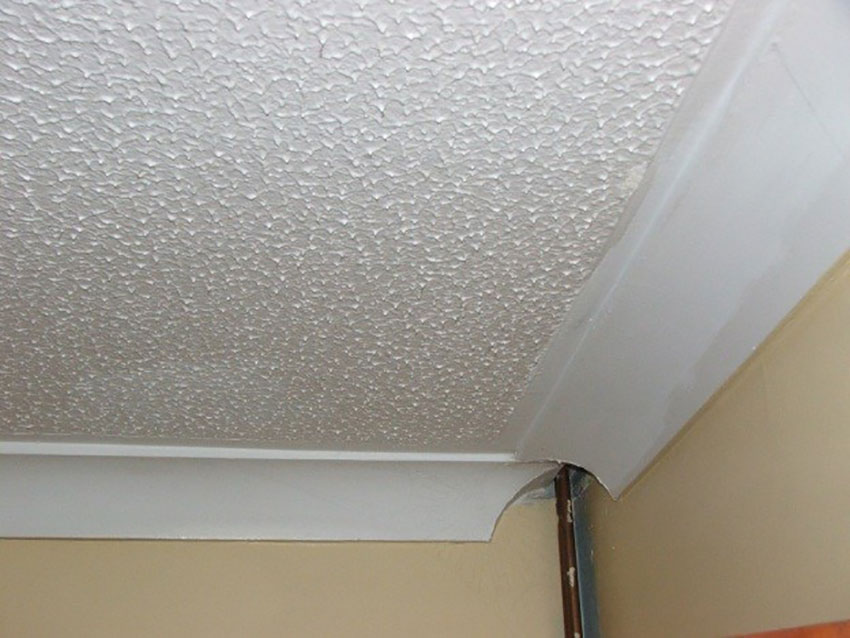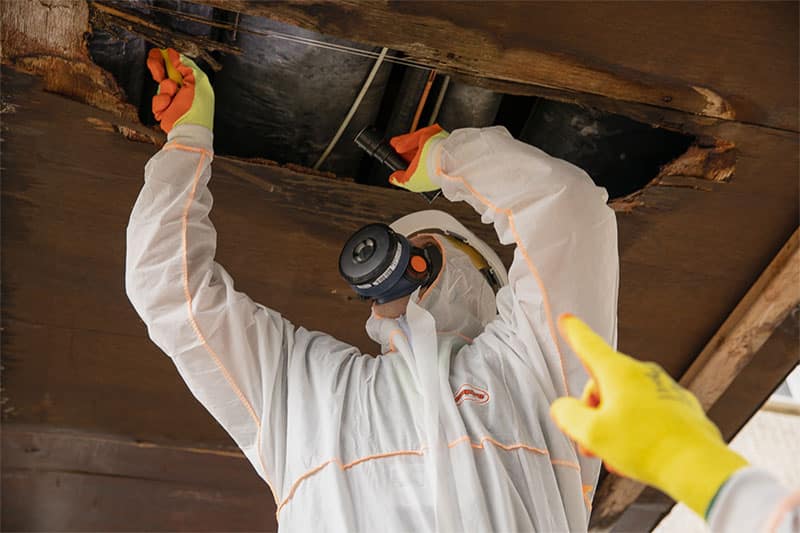How do I know if there is asbestos in my walls?
Asbestos refers to a group of fibrous minerals that are carcinogenic to humans. Before its health risks were understood, asbestos was used in all sorts of construction materials for its fireproofing and insulation properties, including wall materials.
Today, asbestos is no longer used. However, while it was banned in the UK in 1999, any buildings constructed or renovated prior to 2000 may still contain asbestos.
In their regular, undamaged state, asbestos-containing materials (ACMs) don’t pose a risk. Once damaged or disturbed, though, dangerous fibres can become airborne. When inhaled or swallowed, they can stick to the lungs and cause cancer years later.
It’s important to identify asbestos in walls so that it can either remain undisturbed or be removed if it’s no longer in good shape. Even something as minor as putting a nail in a wall that contains asbestos can release fibres that then get inhaled.

Common areas where asbestos might be found
Some of the most common areas where asbestos is found include:
- Cement walls
- Decorative paneling and sprays
- Drywall
- Electrical insulation
- Exterior siding
- Insulation materials
- Joint compounds
- Plaster walls
- Popcorn ceilings
- Soundproofing
- Wallboard
Let’s discuss a few of these areas in more detail.
Cement and concrete walls
Asbestos was commonly added to cement to increase durability, fireproofing, heat resistance and strength. It was an especially helpful addition to thin cement sheeting because it reinforced it.
Popcorn ceilings
A “popcorn” ceiling is one that has an uneven texture, similar in appearance to cottage cheese or popcorn. This popular style can still be seen in homes today that haven’t been updated, and popcorn ceilings are commonly found in entryways and bedrooms.
Assume that your popcorn ceiling contains asbestos, as it was often used to make the material more durable and fireproof.
Humid and wet areas
In addition to its other utilities, asbestos was also used for waterproofing. It can commonly be found in rooms prone to humidity and wetness, like bathrooms and laundry rooms. The sheeting or vinyl tiles in the walls may contain asbestos.
Signs that your walls may contain asbestos
There are a number of signs that indicate your walls may have asbestos. Some of these are obvious, and others require more attention.
Age of the building and renovation history
Since asbestos was so popular in construction prior to its banning in 1999, assume that any buildings constructed before 2000 contain ACMs.
If the building was constructed before 2000 but renovated after that year, it’s possible the asbestos was identified and possibly removed.
In a commercial building, there should be an asbestos register that keeps track of any work with asbestos or work that could have impacted it. However, this documentation isn’t required for a residential building, so it may be unclear if asbestos still exists or not.
Construction materials used
It’s helpful to know the construction materials that commonly contained asbestos, but that still may not give you a thorough idea of every area where asbestos may be present in your building.
Construction-related ACMs include:
- Insulation
- Patching compounds
- Pipes
- Shingles
- Tape
- Textured paint
- Vinyl
Sometimes, the use of asbestos is less obvious. For example, the area around a wood-burning stove may be protected by asbestos paper or cement sheeting. Even if the rest of the wall doesn’t contain asbestos, this one area can.
Visual clues
At times, the appearance or texture of a material can tell you whether or not it contains asbestos, like in the popcorn ceilings described above.
Here’s another example: Look carefully at the wall surface. Is the texture uniform throughout? If you notice that there’s dimpling, similar to a golf ball, this can indicate that asbestos is present.
Also, if you notice an area where a repair patch was inserted, it may contain asbestos. Asbestos joint compounds were often used in patches.
While you can visually inspect your building yourself, it’s best to hire a professional who has experience identifying ACMs and who knows the many places where they may be present.
How to safely check for asbestos in your walls
After identifying the walls that may contain asbestos, you can do a more in-depth visual inspection to see the condition the walls are in.
Generally, undisturbed and undamaged ACMs don’t pose a health risk. Unless they’re likely to be damaged due to something like a renovation project, you can leave them be.
Damaged areas need to be dealt with, though, to reduce asbestos exposure and protect everyone’s health.
Now you need to have it sampled and analysed for the presence of asbestos
When to hire a professional asbestos consultant
It’s always safest to hire a professional asbestos consultant even if you think you have the situation under control. Without experience with asbestos, it’s difficult to recognise where ACMs may be located, assess their condition, and carefully handle the materials for testing purposes.
While it’s not a legal guideline, the Health and Safety Executive recommends that only a competent, trained asbestos professional, like an analyst or surveyor, take the sample.
Furthermore, according to the HSE, “Analysis of asbestos samples is a skilled and specialist task, and trained and competent analysts in analytical laboratories must be used.” The analyst or laboratory must have the International Standard ISO/IEC 17025 accreditation.
Asbestos testing and analysis
To figure out how much of a risk there is in your building, asbestos testing and analysis must be carried out. Let’s discuss two types of testing: bulk sampling and air sampling.
Bulk testing
Bulk testing is used to collect samples of materials that may contain asbestos. The analysis determines if asbestos is present and the type of asbestos present.
It’s common for the water absorption method to be used, too. This process determines if asbestos-containing boards or tiles need a licence to be worked with or if unlicenced work can be performed on them.
Learn more about bulk testing in this PDF from the HSE.
Air testing
Section 5 of Asbestos: The Analysts’ Guide also covers measuring airborne asbestos fibres. The PDF says that sampling “involves the collection of particulates from a measured volume of air by drawing the air through a suitable filter using a pump.” The filter is then examined to determine how many fibres are in the sample.
Pricing for asbestos sampling and analysis varies. The building type and survey type impact the final cost. In our asbestos survey cost guide, we have broken down costs by building type that can give you an idea of what your project may cost.
What to do if asbestos is found
According to the HSE, if you come across asbestos, immediately stop work and prevent anyone else from accessing that part of the building. Carry out a risk assessment, either on your own or with an asbestos expert, and decide if you need a contractor to handle the ACM.
From there, you can determine whether the asbestos work requires a licence or not. The HSE’s guidance about asbestos licensing can be found here.
Asbestos containment vs. asbestos removal
Depending on the severity of the situation, whether or not the ACM may become more damaged in the future, and how the area in question is used, the ACM may either be contained or removed.
Asbestos containment means that it’s encapsulated by a protective barrier to prevent fibres from being released into the air. Sometimes, encapsulation is the only solution needed, and other times it’s a short-term solution until removal work can be done.
Asbestos removal is when the ACMs are removed from the property and safely transported for disposal.
Asbestos safety precautions
Whenever asbestos is worked with, the proper health precautions must be taken. These revolve around ensuring that the fibres aren’t ingested and that they don’t contaminate clothing or the surroundings, which could put others at risk even after the work is finished.
Personal protective equipment, including respiratory protective equipment, is necessary when working with asbestos. It’s also necessary to contain the area and decontaminate everything so as not to spread fibres.
Safely working with asbestos requires experience. To ensure the work is being handled responsibly and that the necessary equipment is available, it’s always best to hire a qualified asbestos removal professional.
Final thoughts
It’s common for older buildings in the UK to contain asbestos in construction materials, including the walls, flooring, ceiling, roofing, and more.
When you find asbestos on your property or suspect its presence, it’s important to address it quickly. This is the only way to prevent an exposure event from happening in the future.
Homeowners and building owners have to be proactive in order to keep themselves, family members, workers, and visitors safe.
Contact Oracle Solutions today if you need help with asbestos on your property.

Written by Brendan Coleman
Brendan Coleman, with decades of experience in the asbestos industry, is a dedicated Quality Manager. Certified as a surveyor and analyst, he is adept in operations and quality management with a keen focus on HSE compliance. His expertise is pivotal in maintaining high safety and efficiency standards. Brendan ensures our UKAS accreditation requirements are consistently met and exceeded, upholding stringent standards in asbestos remediation. His commitment to enhancing quality and customer satisfaction makes him an essential advisor in asbestos management.


